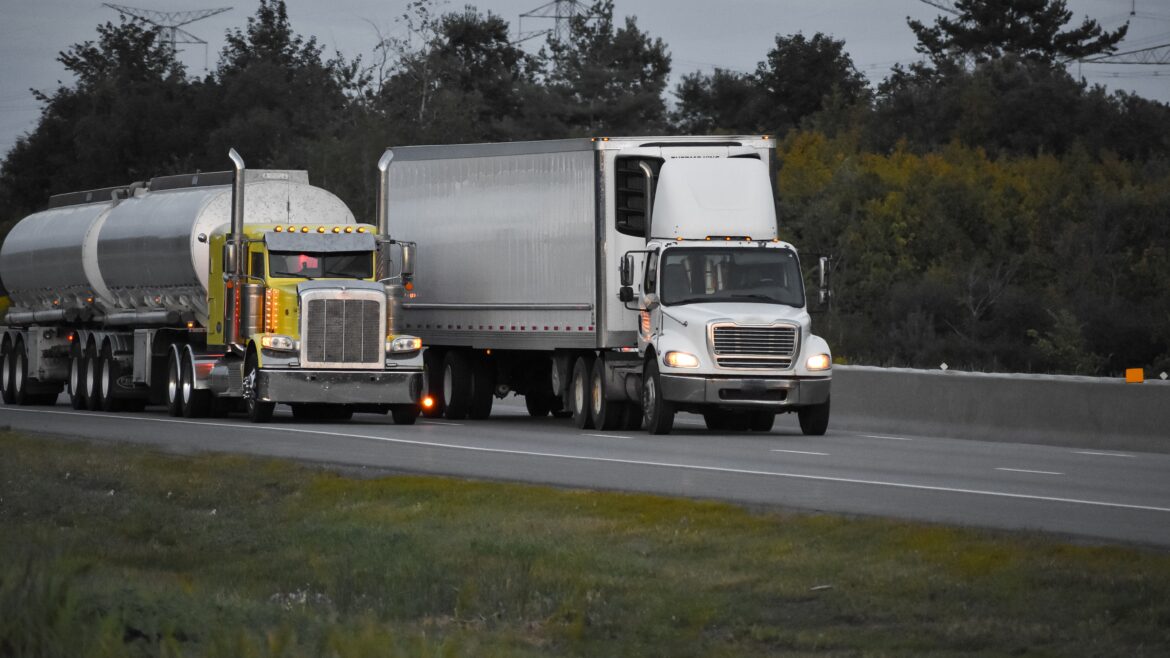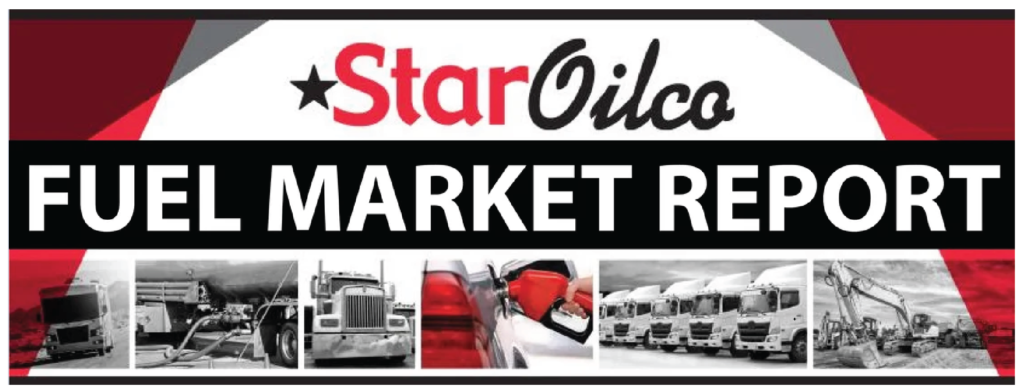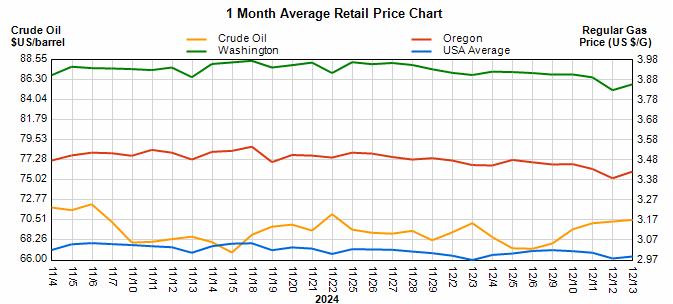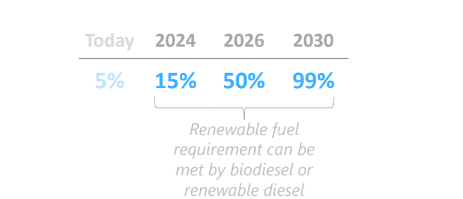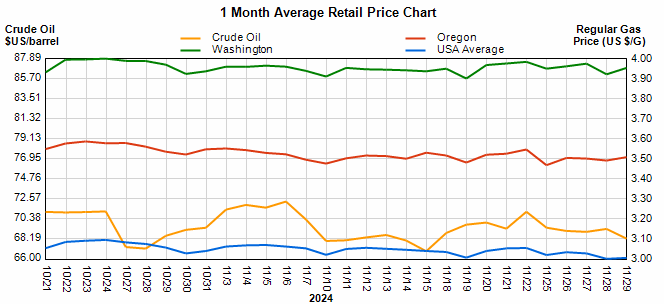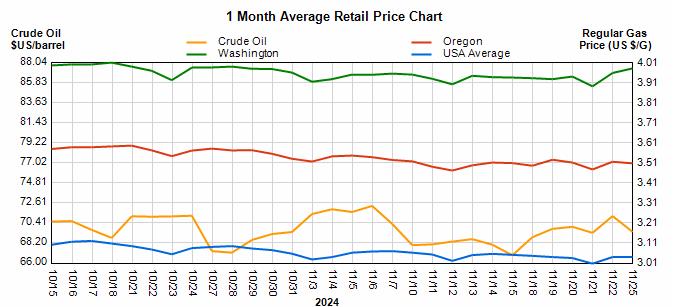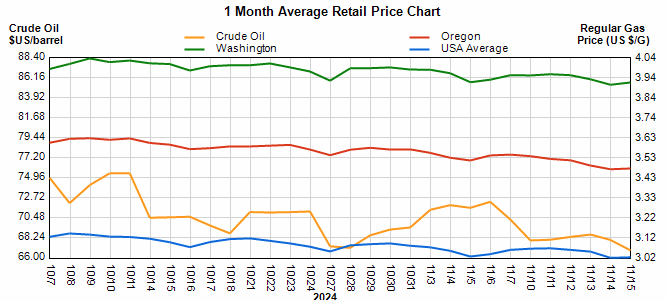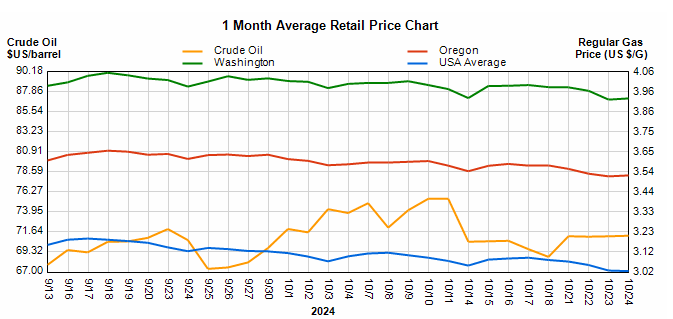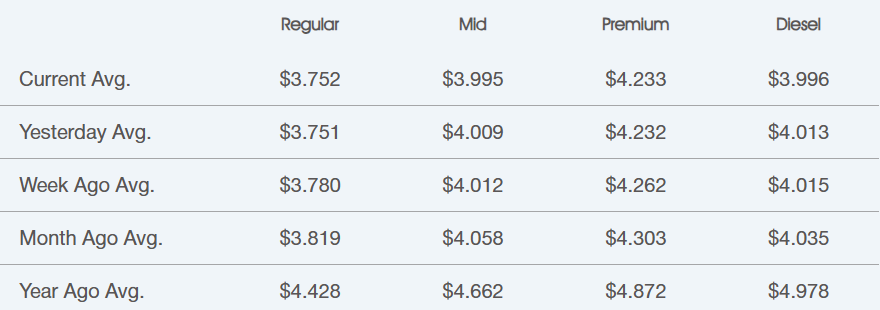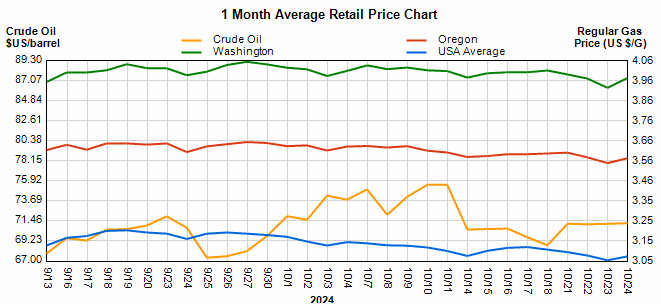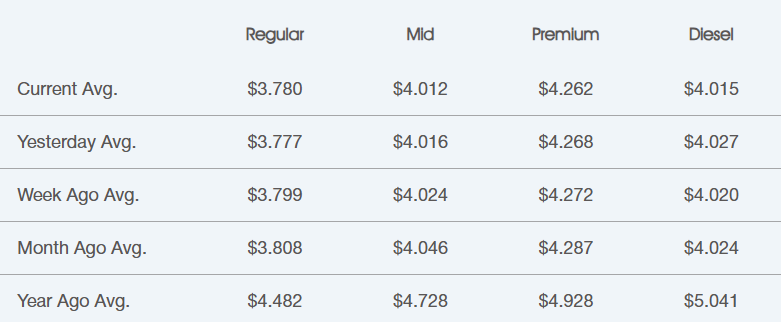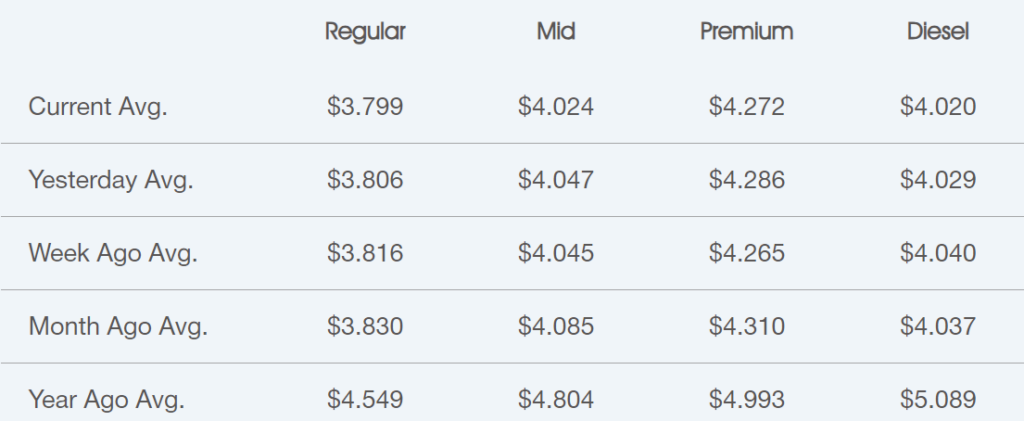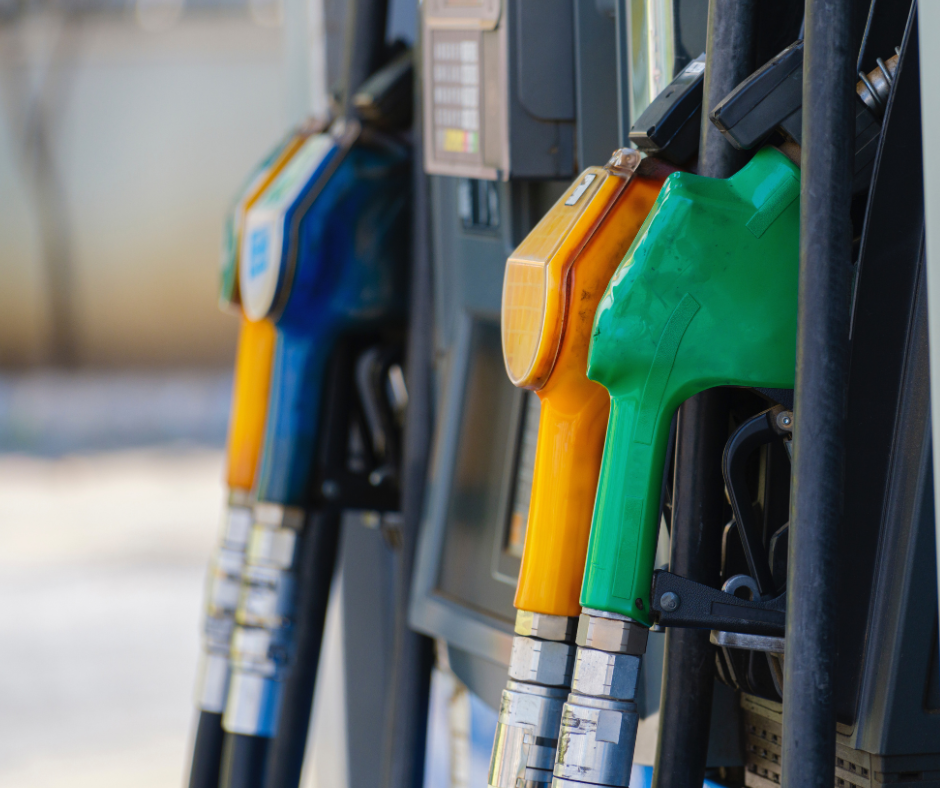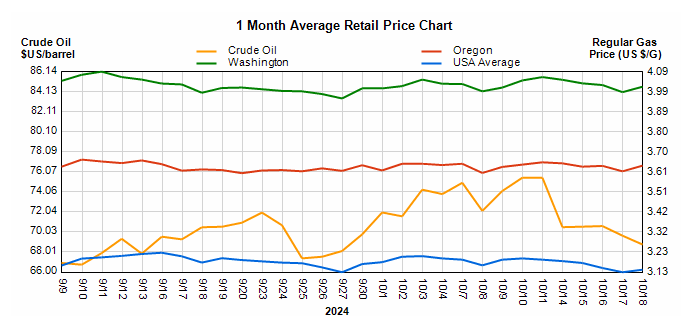Why diesel fuel in Oregon may go up in 2025
What are the market forces impacting diesel in Oregon for 2025?
There are some big changes coming for diesel fuel in Oregon and it is not widely reported. The biggest likely change being a smaller supply of renewable diesel in the first quarter of 2025. Renewable Diesel is expected to see a shorter supply than in recent years as imports drop off with the removal of subsidies.
Oregon is going to see several major market forces impacting the wholesale, as well as retail cost of diesel to those that buy it. To list them simply, the following events will converge on New Years Eve:
– The end of the $1 a gallon US Blenders Tax Credit (BTC) subsidy on biodiesel and renewable diesel.
– The subsidy replacing the BTC, the Producers Tax Credit (PTC), blocks imported biofuels such as Neste Renewable Diesel.
– Oregon is relaunching its Climate Protection Program which will cap the market allowance for fossil fuels.
– Portland has a Renewable Fuels Program that requires the blending of Biodiesel and Renewable Diesel under a 60% reduction in CO2 emissions from petroleum diesel (biofuels sold in Portland must be below a 40CI under Oregon’s Clean Fuels Program).
– California has mandates for Renewable Diesel in many uses raising the cost of R99 renewable diesel throughout the US.
These forces will raise the cost of fossil fuel diesel, renewable diesel and biodiesel while at the same time Oregon and Portland are requiring the use of these biofuels. This will mean a higher retail and wholesale price inside Oregon compared to the rest of the United States. We cover the details of these trends below in depth.
THE OREGON CLIMATE PROTECTION PROGRAM
The biggest change impacting the price for on-road diesel is the return of Oregon’s Climate Protection Program (CPP). The program’s more common name is Cap and Invest, in fuel pricing it is referred to as “Cap at the Rack” as its allowance requirements are priced on a gallon of fossil fuel. The program caps the total fossil fuel allowed to be sold inside Oregon. Then, revenue generated from selling the allowances to import CO2 contributing fossil fuels into the state, is invested to reduce future needs for these fuels. In 2025, this program will return and fuel importers into the state of Oregon will have to capture the cost of reducing their CO2 emissions under this program.
Oregon previously had a “Cap and Invest” program limiting the total market share allowed for petroleum diesel fuels. This created a higher cost for diesel fuels refined from petroleum compared to renewable diesel and biodiesel. This program was stopped by an Oregon court decision in 2023. The Oregon Department of Environmental Quality (DEQ) just finished and published the new rules for this program correcting the issues the court had with the program.
The way the Oregon Cap and Invest works on the market is similar to musical chairs. If you imagine the market for diesel is limited just like seats in musical chairs, every year they will take a few of the fossil fuel chairs away. That means that anyone maintaining their existing customer gallons or trying to grow their volumes must meet this demand with renewable diesel, biodiesel or some other fuel. The limited market for fossil fuels is represented by “Allowances” provided by the Oregon DEQ. If a fuel seller cannot reduce their fossil fuel dependency, they need to buy a CPP Allowance in an Oregon DEQ curated market for them.
The value of these CPP Allowances is actually charged on each gallon of fuel sold by the regulated parties. It is commonly called “Cap at the Rack” and can range in cost from nothing to over $.50 a gallon depending on how hard it is to meet the need of the program. The biggest impact on the Cap at the Rack cost is how much renewable diesel or biodiesel is being used by those selling fuel. Prior to the stoppage of Oregon’s CPP program, the Cap at the Rack cost usually ran around $.05 to $.30 a gallon. It is expected we will see a return to this cost starting January 1st, 2025. OPIS reports have an adjusted and non-adjusted option to capture the cost of this program.
The way the CPP program is designed is that if a fuel seller brings in a lower CO2 fuel like renewable diesel or biodiesel into the state of Oregon those gallons do not count towards the fossil fuel market cap. So a R99 seller has no CPP Allowance obligations for those gallons. A B20 biodiesel blender, as well, picks up 20% more gallons available to sell as those biodiesel gallons do not count against their CPP Allowances. This facet of the CPP is why the market of renewable diesel in particular is a big deal for diesel prices.
The intent of Oregon is for consumers, fleets, farmers, municipalities, and industry in Oregon to grow their energy needs, they will need to use more low carbon energy. If this energy use is a fleet running over 32,000 GVW this will mean low CO2 biomass based diesel fuels. At the same time, the CPP program is kick-starting back into existence, the world of these biofuels is seeing some major market changes.
OREGON CLEAN FUELS PROGRAM
Oregon has another program to reduce the CO2 of the liquid fuels sold inside the state. This program is additional and works in conjunction with the CPP. It is the Clean Fuels Program (CFP) and is extremely similar to the California Low Carbon Fuel Standard (LCFS). This program creates a market for Carbon Credits that are traded and required by fuel importers into Oregon. OPIS also shows this program’s cost per gallon on their reporters.
Where the Climate Protection Program is like musical chairs with market share as the allowed market for fossil fuel shrinks year over year, the Clean Fuels Program is like a coupon required with sales of fossil fuel. The major importers of fossil fuels into Oregon must show they are blending lower CO2 biofuels by presenting CO2 credit generated under the CFP program. Users of fuel inside Oregon also see a benefit for bringing in low CO2 fuels when the market needs the credits so that voluntary users of high blend biofuels like R99, B99, B20 or E85 (85% ethanol) get financial support via a reduced final cost per gallon if using those fuels.
The reason we see renewable diesel in Oregon compared to the rest of the United States is because of this program. This value of a Carbon Credit is usually taken to buy down the competitive price of these biofuels. The concept is that if a fuel importer is bringing low CO2 fuels into Oregon, the reduction in CO2 these fuels represent can generate a CO2 credit. That credit being sold on an open market to help reduce the cost of a low CO2 fuel compared to a fossil fuel. The market for these credits is banked and has been building for years. Currently, the CO2 value is low as there are plenty of credits.
If the market availability of renewable diesel and biodiesel is dropping, the value of these credits should be rising. The overall market will be bearing this cost though consumers will likely never see it. In effect these regulatory market impacts of less renewable diesel in Oregon will mean a higher Carbon Credit price under the CFP program. That will help lower the blended or delivered costs of B99 biodiesel and R99 renewable diesel hitting the end consumer.
RENEWABLE DIESEL AND BIODIESEL SUPPLY IN OREGON
Biodiesel and renewable diesel are called “Biomass Based Diesel” as a respective class of biofuels. Where fossil fuel diesel is made from crude petroleum, biomass based diesels are diesel fuels made by several technologies from biomass feedstocks. The most widely used feedstock being fats, oils, and greases from virgin vegetable seed oils (soy and canola) or waste streams like recycled deep fryer oils, meat processors rendering fats, recovered trap greases, and many other sources of fat waste streams.
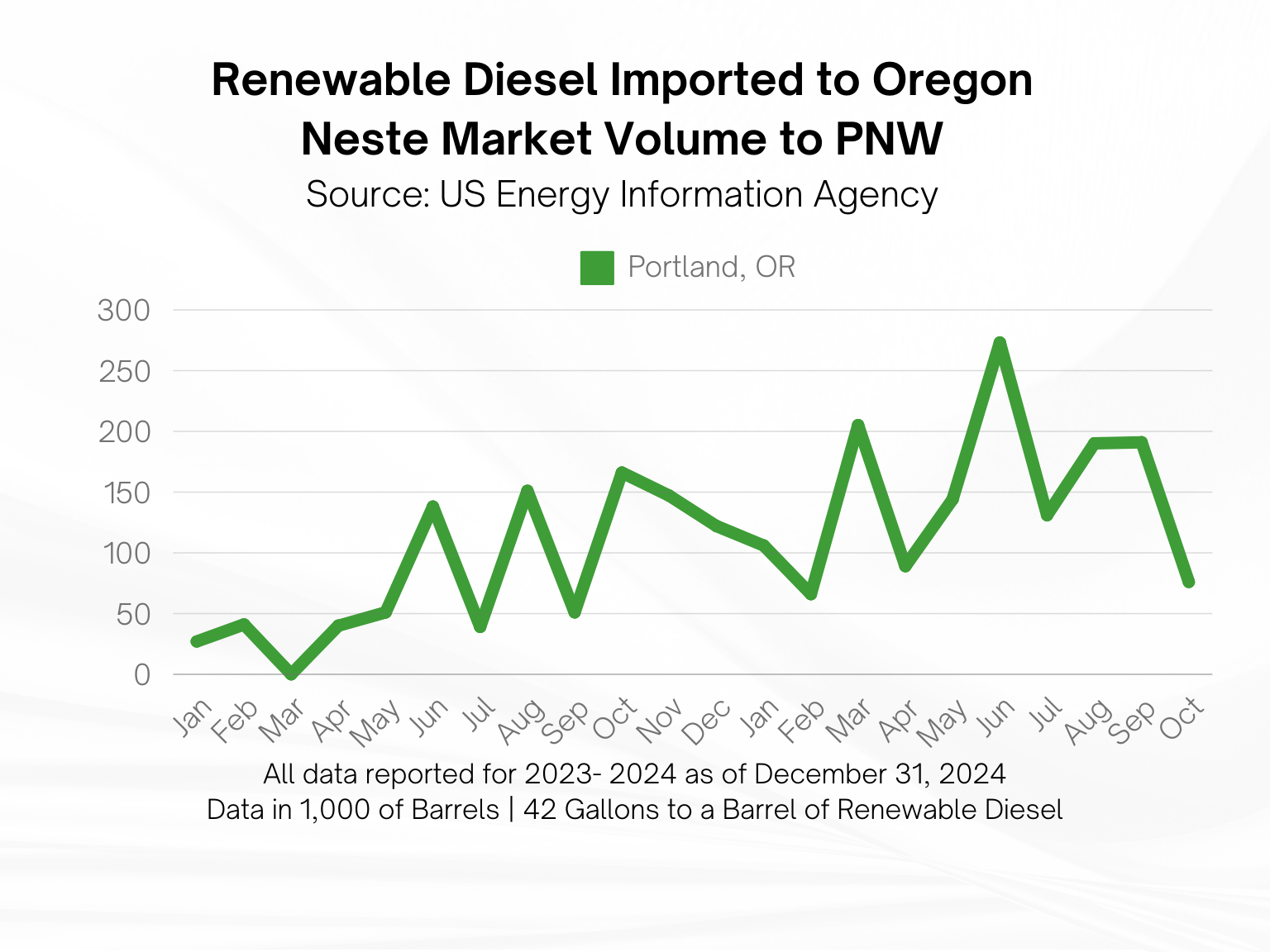
The 2025 Oregon Fuels Forecast for Oregon predicts a 199+ million gallon need for R99
The Oregon Department of Administrative Services Office of Economic Analysis produces a Clean Fuels Forecast which describes the size of the market need in Oregon. In 2023, Oregon used 133.3 million gallons of R99 inside the state. The fossil fuel diesel used in 2023 was 577.6 million gallons by comparison. So R99 and B99 blended with those gallons is a substantial 26% of the diesel burned in Oregon by the most recent total data. The forecast for 2024 Renewable Diesel is 46.6 million gallons of R99, which appears to be exceeded by quite a bit.
We do not have total consumption numbers for 2024 yet, but we do know thanks to the US Energy Information Agency, that imported R99 from Neste Singapore by itself through October was roughly 62 million gallons rounding up. The Oregon Clean Fuels Forecast expects 199.5 million gallons of renewable diesel in 2025. As the program ramps up with this expectation, the imports of previous years will be far less competitive without subsidies. This means the price of renewable diesel will be higher, unless US production scales to not only fill this market void but also add tens of millions of gallons into the state.
Of that 133.3 million gallons of R99 used in 2023 in Oregon, a third, more than 40 million gallons of it was imported Neste Renewable Diesel. 973,000 barrels of renewable diesel was shipped from Singapore to Oregon that year. Other renewable diesel refiners such as Diamond Green, HF Sinclair, Marathon, Montana Renewables, Phillips 66 and Chevron also had R99 product sold into Oregon. Regardless of the expansion of US domestic Renewable Diesel production in recent years, the Neste product no longer receiving subsidies will have a real impact to maintain these 133+ million gallons of R99 inside Oregon.
This same projection reports that Oregon’s B99 Biodiesel use inside the state in 2023 was 78.8 million gallons. With a projection of Biodiesel to rise 83.8 million gallons in 2025. Given these market needs, Star Oilco predicts R99 to be expensive compared to petroleum diesel. Biodiesel will be more competitive given the available product and no substantial change in suppliers. Biodiesel will also need to be used to replace R99 gallons under the CO2 reduction programs of Oregon. Due to these market forces Star Oilco has contracts for supply at reasonable prices for our existing customers.
R99 is mandated in certain diesel uses in California by the California Air Resource Board (CARB) which make for an inelastic price. Diesel equipment operators in California will have to buy R99 at any price. This will raise the prices we in Oregon can expect to see renewable diesel at. The other low CO2 diesel fuel biodiesel will not be impacted by CARB the same way and we can expect to see B20 become more widely sold because of its more competitive price.
Biodiesel has a much more widely used market development around the US, especially in over-the-road trucking. The plants that make biodiesel also tend to be co-located, owned in collaboration with feedstock producers, and integrated within the Soy industry that produces the feedstock. Expect that biodiesel will continue to be more competitive with diesel than renewable diesel if price is the concern.
It is worth mentioning that the CARB mandates for R99 use in California will have impact to set the price for renewable diesel in other states. If the market demand mandated by CARB continues and the market is short, the price can be expected to rise to meet this demand. So unsubsidized imported R99 will likely continue to flow into California and other states but it will be at a full cost to make up the subsidy. This will likely mean that incremental gallons of R99 needed to meet the market growth projected in Oregon will be at a premium over Oregon diesel to match California’s diesel market.
US BLENDERS TAX CREDIT EXPIRATION IMPACTING OREGON
The biggest unknown on how expensive diesel will be for Oregonians relates to Federal biofuel policy. For the last twenty years the US Government has had an on-again/off-again subsidy on biodiesel and more recently renewable diesel. There have been years the subsidy was not renewed which informs us of what probably will happen with prices on biodiesel. Renewable diesel though is a stickier market. The reaction of R99 renewable diesel prices in California, Washington and Oregon market is the big question and it comes down to an issue of production. Two big issues at play are how much renewable diesel will these states continue to see from Neste’s Singapore plant and how much new US production for renewable diesel comes online to feed the market need.
The Blenders Tax Credit will be replaced with the Producers Tax Credit
The Blenders Tax Credit expired December 31st. There are those that hope that in January the new Congress will take up an extension of this but most experts in the industry do not expect and are not betting an extension will not occur. Meanwhile there is subsidy regime named the “Clean Fuels Production Credit” or the slang term preferred by industry the Producers Tax Credit (PTC) which ranges from $.20 a gallon to $.80 a gallon depending on how low CO2 the fuel as well as some labor practices. The PTC also bars imported renewable diesel and biodiesels from getting any money at import. Approximately more than 40,000,000 gallons a month of renewable diesel flows from Neste Singapore to the west coast, this will have a huge impact on Oregon. For those accustomed to that fuel at the same price as fossil fuel diesel, the expiration of this subsidy will raise our prices for those demanding R99 renewable diesel which was already in short supply prior to this change.
There is also another wrinkle in the subsidy policy of the US with this. The subsidy on Sustainable Aviation Fuel (SAF), basically renewable diesel meeting the Jet A fuel specification, is still in place for imported product for another year. Europe also has some significant incentives and mandates for SAF. Renewable diesel refiners, both domestic as well as foreign have a huge financial incentive to make renewable jet fuel over renewable diesel. This reality probably means that if a gallon of fuel can go to a jet fuel market over a transportation market it will.
So the market forces for renewable diesel in particular probably means less R99 available nationwide in the US. While that is happening, the state of California has mandated that all off road equipment run R99 Renewable Diesel. So regardless of what the price of this fuel is, California will have to use it in huge volumes. Markets being what they are, for high volume fleets demanding R99 they can expect the R99 price in Oregon will track the price paid in California. There will be exceptions of contract relationships for supply of R99 as well as retail brands moving renewable diesel blends to meet their strategic CPP requirements. This will definitely mean anyone wanting R99 will want to line up a contractual supply agreement or can expect a higher price than in 2024.
THE FEDERAL RFS AND RINS
It should also be mentioned that the US EPA has a Renewable Fuel Standard of its own. It is a completely different regulatory system compared to the Portland RFS. This program requires gasoline refiners as well as importers to use so much biofuel in their sales inside the United States. Federally refiners and importers must prove they blended specifically assigned amounts of ethanol, and biomass based diesel fuels.
This program attaches a Renewable Industry Number (RIN) on every gallon of biofuel sold in the US. As there are many unobligated users of this biofuel in the US those blending their own biodiesel, renewable diesel and ethanol generate RINs that can be sold to the refiners and importers of gasoline inside the US.
The RIN value has been low compared to historic values for biomass based diesels. As Biodiesel and Renewable Diesel generate the same type of RIN, the reduction in imported R99 might raise the value of these RINs. This value increase for the Renewable Industry Number is expected to slightly off set the hard subsidy. It will be a market based value so it can not be relied upon for lowering the cost of biofuels, but can be expected to help with price.
As more US produced renewable diesel is coming online, hopefully enough to replace the lost imported gallons before the busy summer diesel season, these RIN values may not have a major contribution to the wholesale price of R99.
CONCLUSION
We predict diesel prices to rise in Oregon compared to the US in the first quarter of 2025
Star Oilco’s team saw these market conditions coming during the summer of 2024. We have locked in contractual supply of R99 renewable diesel for our existing customers and have additional supply for customers seeking R99 renewable diesel by Star Oilco owned cardlock sites, mobile onsite fueling or smaller volume bulk delivery.
Star Oilco expects a Cap at the Rack price from the Oregon CPP to be between $.10 and $.40 a gallon by the end of January depending on biofuel supply. With unofficial conversational predictions with several large fossil fuel refiners and brokers, there is an expectation of over $.25 a gallon as a Cap at the Rack price. We think it will be higher than that with the removal of millions of gallons of R99 from Oregon’s market. In the first quarter with the removal of imported R99 hitting the state we expect the Cap at the Rack price to start in the higher $.30 a gallon range where it left off when the program was ended by a court. As the low CO2 exempt renewable diesel gallons shrink in the first quarter a heavier reliance on fossil diesel will be required.
We expect quite a bit of biodiesel to be loaded up ahead of the $1 a gallon subsidy being ended on December 31st. Renewable diesel will be in short supply due to disruptions in supply of imported product. So first quarter R99 will be at a premium and B99 for blending with diesel will be a deal to be had as fossil fuel diesel prices rise. Expect to see far more B10 and B20 offered in the market place as either a more common than not fuel at retail gas stations, truck stops, and most cardlock stations, especially in Portland. Star Oilco will have options for our customers of either B20, R99, or R20 blends of diesel all complying with the City of Portland Renewable Fuel Standard inside the city. Star Oilco’s Portland CFN and Pacific Pride locations will have both R99 and B20 hoses available for customers.
California will continue to demand any and all R99. If the market is short R99 because of a removal of imported renewable diesel, the value of R99 in California will rise to justify foreign R99 to enter the market without a subsidy. Star Oilco presumes that number will be between $.40 to $.80 a gallon. If R99 in California is able to demand a premium, Oregon will have to pay that price for incremental gallons. Oregon has a specific need for R99 and B99 for retail gasoline sellers to meet the Climate Protection Program (if you sell so much gasoline you must reduce your market share someplace and R99 diesel is the easiest way to do that). Oregon retailers will be seeking to move a budgeted amount of renewable diesel and biodiesel to meet their fossil fuel allowance budgets under the CPP. Each gallon beyond that will have to compete with California at a high price.
R99 will still be available but we expect incremental gallons to be at a premium. Contractual gallons direct with a refiner of renewable diesel will have a consistent price that a business can manage fuel surcharges against diesel. Outside of a contract for volumes, the wholesale rack price of R99 may vary wildly compared to a B5 ULSD fossil fuel diesel prices depending on how high diesel is going for are as well as the CPP and CFP values of a Carbon Credit and Cap at the Rack.
The big unknown to price is how one key importer of R99 will respond to the market without a subsidy. It is the assumption of Star Oilco that California will continue to buy imported R99 without a subsidy for it’s off-road mandated market. If the economics of Neste are such, they can compete and open the floodgates of R99 and this could change. This open flood of product is not expected especially given the economics of Sustainable Aviation Fuel which renewable diesel plants are expected to make more of in 2025.
The Oregon and Washington market will see a flow of new capacity of R99 for retailers mandated to reduce their fossil fuel volumes. US production of R99 is expected to more than compensate by 2026, but 2025 will be a chasm to jump. Chevron, HF Sinclair, Marathon, and Phillips 66 will be procuring and supplying US made biomass based diesel to the Pacific NW for their retail gas station needs. We would expect to see R99 or blends of it sold at parity with branded diesel in the retail market in Oregon.
Commercial sellers of wholesale unbranded diesel will have a tougher time lining up R99 at a price in line with wholesale B5 or B20 ULSD. No doubt with these higher prices we will be seeing an evolution of R20 (20% renewable diesel) as well as blends of biodiesel with renewable diesel available inside the City of Portland for it’s Renewable Fuel Standard as a premium fuel at a competitive price with diesel.
Star Oilco has R99 and R20 blends for commercial customers in the Portland, Oregon area. We also have R99 available for Clark County Washington commercial and municipal fleets. Star Oilco also has biodiesel blends and can support fleets seeking to succeed with it. Call us if you would like to talk about your fuel supply in 2025.
If your fleet has an interest in a consistent and contractual supply of R99 renewable diesel or wants to develop a relationship that prioritizes a 20% of renewable diesel blended to meet Portland’s Renewable Fuel Standard compliance please feel free to reach out to Star Oilco.
For further reading of news coverage of the Oregon Climate Protection Program please see the following:
KGW8 – Climate Protection Program returns after being struck down by court
KATU2 – Oregon adopts Climate Protection Program to cut fossil fuel pollution by 90% by 2050
Oregon Capital Chronicle – Redo of Oregon program to cap greenhouse gas pollution ready for public review.
The Oregonian – Oregon restores signature Climate Protection Program to cut greenhouse gases.
Central Oregon Daily News – Oregon commission approves redo of landmark climate program after lawsuit derailed it
Oregon Public Broadcasting – Oregon to reinstate ambitious climate program amid divided reactions from industries, environmentalists
US Energy Information Agency: Biofuels Displacing Petroleum on the West Coast
Reach Out To Our Team
Our team of fuel experts would be happy to work with you and help you understand how this affects your operations



